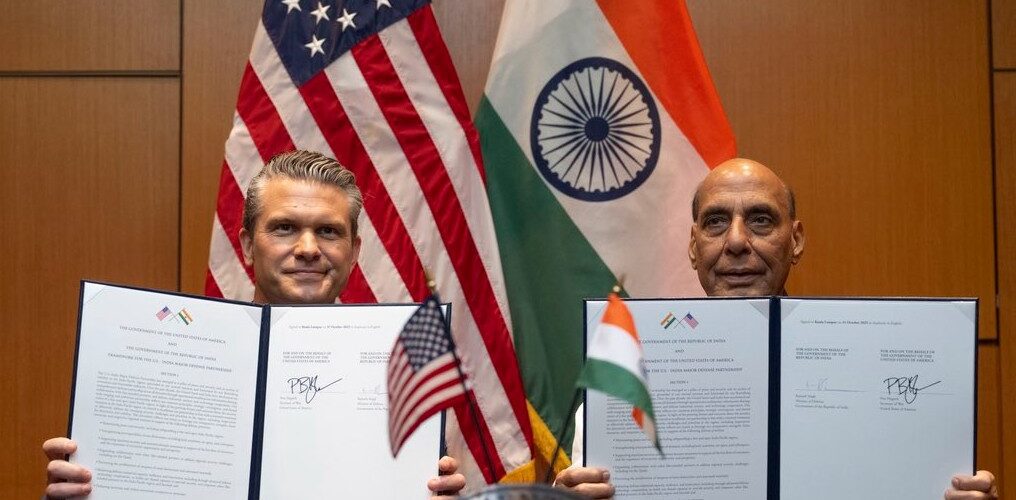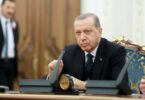Executive Summary
On 31 October 2025, the United States and India signed a 10-year Defence Framework Agreement in Kuala Lumpur, formalised by U.S. Defence Secretary Pete Hegseth and Indian Defence Minister Rajnath Singh. This accord represents a strategic deepening of bilateral defence cooperation, establishing a structured roadmap for the next decade. It focuses on information sharing, joint training, technology exchange, and regional deterrence, signalling an enhanced strategic alignment between the two nations in the Indo-Pacific.
Background
U.S.–India defence relations have steadily evolved over two decades—from limited exchanges in the early 2000s to a comprehensive strategic partnership by the 2020s. Milestones include the 2005 and 2015 Defence Framework Agreements, foundational pacts such as LEMOA (2016),
COMCASA (2018), and BECA (2020), and the emergence of the Quad Security Dialogue. The 2025 Framework builds upon these initiatives to institutionalise cooperation through a 10-year plan of engagement.
Key Provisions of the 2025 Framework
- Duration and Scope: The framework spans 2025–2035, establishing a formal mechanism for sustained cooperation.
- Technology and Industrial Cooperation: It expands joint R&D;, production, and industry linkages between U.S. and Indian defence sectors.
- Information Sharing: Enhances interoperability and communication systems.
- Joint Military Activities: Institutionalises annual joint exercises and officer exchanges.
- Regional Security: Commits both sides to peace, stability, and freedom of navigation in the Indo-Pacific.
Strategic Assessment
The framework reinforces mutual strategic objectives. For the U.S., it secures India’s role as a regional partner to strengthen deterrence. For India, it provides access to technology and diversification from traditional suppliers. Economically, it supports India’s ‘Atmanirbhar Bharat’ initiative. Geopolitically, it contributes to regional balance amid rising Indo-Pacific tensions.
Analysis and Outlook
The Framework is a landmark in long-term strategic trust. Its success depends on clear deliverables, transparent technology exchange, and coordinated diplomacy. If executed effectively, it could redefine Indo-Pacific security by enhancing India’s defence industry, strengthening deterrence, and deepening the U.S.–India partnership through 2035.

Strategic Drivers: The China and Indo-Pacific Context
This framework cannot be divorced from the broader Indo-Pacific calculus. The U.S. has been building a network of like-minded security partners—from Japan and Australia (through the Quad) to the Philippines and Vietnam—to counterbalance China’s growing naval reach and economic influence. India, the largest democracy and regional military power, is now central to that vision.
By formalising a decade-long framework, Washington signals it views New Delhi not as a temporary partner but as a co-pillar in the regional order. The message is equally directed at Beijing: the U.S.–India partnership will persist beyond electoral cycles or shifting administrations.
Technology and Capability: Beyond Joint Exercises
The framework’s emphasis on technology sharing and co-development reflects a maturation of defence ties that were once limited to symbolic joint drills. India has long sought access to advanced American platforms—ranging from jet engines to intelligence systems. This pact could unlock those channels, especially through co-production initiatives in defence manufacturing.
Defence analyst Lt. Gen. (Dr.) Rakesh Sharma (Retd) told Moneycontrol that the agreement “institutionalises interoperability goals and could catalyse India’s long-standing ambition for indigenous production under its ‘Make in India’ programme.” (Moneycontrol, 2025)
Such cooperation could also mitigate India’s dependency on Russian defence hardware—a relationship that has complicated U.S.–India cooperation in the past. The framework might thus serve as a gradual pivot from legacy systems to interoperable, Western-standard technologies.
Geopolitical Significance: Continuity Across Administrations
The timing of the pact—signed on the sidelines of the ASEAN Defence Ministers’ Meeting-Plus in Kuala Lumpur—is symbolic. It reinforces India’s role as a security anchor in the Indo-Pacific and situates its partnership with the U.S. within a multilateral context.
For Washington, it’s also a test of strategic continuity. Previous administrations have courted India under different labels — “Major Defense Partner,” “Comprehensive Global Strategic Partnership” — but this 10-year framework marks the first structured commitment across a decade. It binds future policymakers to a shared security trajectory, institutionalising a relationship often reliant on political goodwill.
Challenges and Constraints
The framework faces real-world constraints:
- Technology transfer limits: U.S. export controls and congressional oversight often slow the pace of sensitive defence cooperation.
- India’s multi-alignment: New Delhi continues to balance ties with Moscow and Tehran, making deep U.S. alignment diplomatically complex.
- Operational asymmetries: Interoperability between the two militaries—especially in communications and logistics—remains uneven, despite progress under foundational agreements like COMCASA and BECA.
An unnamed Indian official, cited by Reuters, cautioned that “frameworks are only as effective as their implementation mechanisms,” hinting that bureaucratic inertia could blunt the pact’s potential. (Reuters, 2025)
Analysis: A Strategic Bet on the Future
This agreement is, above all, a strategic bet—one that both nations are willing to stake on shared long-term interests. For the U.S., it means committing to an India that remains non-aligned but increasingly cooperative. For India, it means embracing a partnership that enhances its global stature while diversifying its defence ecosystem.
If implemented effectively, the framework could redefine South Asian deterrence dynamics, integrate Indian industries into global defence supply chains, and shape the technological balance of the Indo-Pacific over the next decade.
But its success will hinge on how both governments translate rhetoric into action—moving from ceremonial photo-ops to joint production, secure communication links, and sustained information sharing.
Conclusion
The 10-year U.S.–India Defence Framework represents a shift from episodic engagement to structured alignment. It codifies what has long been an unstated reality: that Washington and New Delhi see each other as indispensable partners in maintaining a stable, open Indo-Pacific.
As Hegseth put it, “Our strategic alignment is built on shared interests, mutual trust, and a commitment to a secure and prosperous Indo-Pacific.” (Moneycontrol, 2025)
References:
Reuters, U.S. signs 10-year defence pact with India (2025)
Firstpost, India–U.S. sign 10-year defence framework after Rajnath–Hegseth meeting in Malaysia (2025)
Moneycontrol, India–U.S. sign “ambitious” 10-year defence framework: A significant step for our militaries (2025)
More on similar topics:
Zangnan: between the Chinese Dragon and the Indian Lion: https://www.thestrategicperspective.org/zangnan-between-the-chinese-dragon-and-the-indian-lion/
Munir’s Anti-India prattle and blame games: https://www.thestrategicperspective.org/munirs-anti-india-prattle-and-blame-games/
BRICS nations band together against Washington’s tariff threats: https://www.thestrategicperspective.org/brics-nations-band-together-against-washington-tariff-threats/
Arab-Islamic NATO: https://www.thestrategicperspective.org/arab-islamic-nato/










